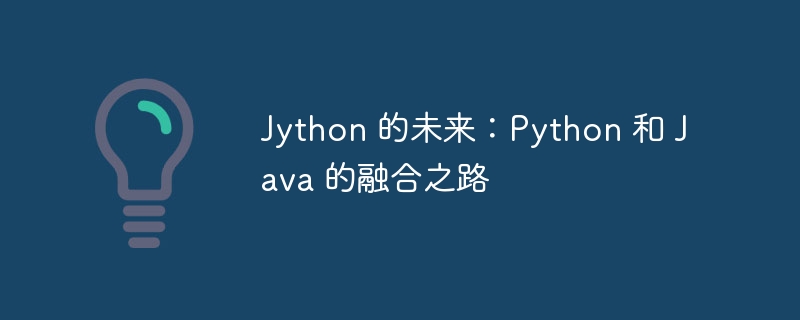 Backend Development
Backend Development
 Python Tutorial
Python Tutorial
 The future of Jython: The road to the integration of Python and Java
The future of Jython: The road to the integration of Python and Java
The future of Jython: The road to the integration of Python and Java

Dynamic typing: Jython inherits python’s dynamic typing system to provide runtime flexibility. It eliminates the need to specify variable types at compile time, allowing developers to create code faster and easier.
Cross-platform support:Jython can run on any platform running JVM, including windows, MacOS and linux. This ensures code portability and eliminates issues with binding to a specific operating system. Jython Application
Jython has applications in a wide range of fields, including:
- Automation and Scripting:
- Jython can be used to automate tasks, perform repetitive operations, and create interactive scripts. Data Analysis:
- Integration with Java libraries such as NumPy and SciPy, making it a powerful tool for data analysis and machine learning tasks. Web development:
- Jython can be used with JAVA WEB frameworks (such as spring and Struts) for WEB Applications provide dynamics and flexibility. Game Development:
- Jython's dynamic typing and cross-platform support make it a valuable tool in game development, especially for scripting game logic and creating mods. The future of Jython
Jython is bright as it continues to play an important role in the
Pythonand Java communities. With the development of artificial intelligence and machinelearning, there is a growing demand for bridge technologies such as Jython, as it can promote collaboration between different programming languages. In addition, with the popularity of
cloud computing, Jython has also gained attention in devops and infrastructure automation. Its dynamic typing and cross-platform support make Jython ideal for quickly adapting and deploying cloud applications. To stay relevant and competitive, Jython
projectis constantly being updated and improved. These improvements include support for Python 3, enhanced integration with Java 11 and later, and improved support for Big Data frameworks such as Apache spark. Through continued development and community support, Jython is expected to continue to provide an important bridge between the Python and Java ecosystems, providing developers with unique opportunities to leverage the benefits of both
programminglanguages.
The above is the detailed content of The future of Jython: The road to the integration of Python and Java. For more information, please follow other related articles on the PHP Chinese website!

Hot AI Tools

Undresser.AI Undress
AI-powered app for creating realistic nude photos

AI Clothes Remover
Online AI tool for removing clothes from photos.

Undress AI Tool
Undress images for free

Clothoff.io
AI clothes remover

AI Hentai Generator
Generate AI Hentai for free.

Hot Article

Hot Tools

Notepad++7.3.1
Easy-to-use and free code editor

SublimeText3 Chinese version
Chinese version, very easy to use

Zend Studio 13.0.1
Powerful PHP integrated development environment

Dreamweaver CS6
Visual web development tools

SublimeText3 Mac version
God-level code editing software (SublimeText3)

Hot Topics
 1377
1377
 52
52
 How to solve the permissions problem encountered when viewing Python version in Linux terminal?
Apr 01, 2025 pm 05:09 PM
How to solve the permissions problem encountered when viewing Python version in Linux terminal?
Apr 01, 2025 pm 05:09 PM
Solution to permission issues when viewing Python version in Linux terminal When you try to view Python version in Linux terminal, enter python...
 How to efficiently copy the entire column of one DataFrame into another DataFrame with different structures in Python?
Apr 01, 2025 pm 11:15 PM
How to efficiently copy the entire column of one DataFrame into another DataFrame with different structures in Python?
Apr 01, 2025 pm 11:15 PM
When using Python's pandas library, how to copy whole columns between two DataFrames with different structures is a common problem. Suppose we have two Dats...
 How to teach computer novice programming basics in project and problem-driven methods within 10 hours?
Apr 02, 2025 am 07:18 AM
How to teach computer novice programming basics in project and problem-driven methods within 10 hours?
Apr 02, 2025 am 07:18 AM
How to teach computer novice programming basics within 10 hours? If you only have 10 hours to teach computer novice some programming knowledge, what would you choose to teach...
 How does Uvicorn continuously listen for HTTP requests without serving_forever()?
Apr 01, 2025 pm 10:51 PM
How does Uvicorn continuously listen for HTTP requests without serving_forever()?
Apr 01, 2025 pm 10:51 PM
How does Uvicorn continuously listen for HTTP requests? Uvicorn is a lightweight web server based on ASGI. One of its core functions is to listen for HTTP requests and proceed...
 How to dynamically create an object through a string and call its methods in Python?
Apr 01, 2025 pm 11:18 PM
How to dynamically create an object through a string and call its methods in Python?
Apr 01, 2025 pm 11:18 PM
In Python, how to dynamically create an object through a string and call its methods? This is a common programming requirement, especially if it needs to be configured or run...
 How to avoid being detected by the browser when using Fiddler Everywhere for man-in-the-middle reading?
Apr 02, 2025 am 07:15 AM
How to avoid being detected by the browser when using Fiddler Everywhere for man-in-the-middle reading?
Apr 02, 2025 am 07:15 AM
How to avoid being detected when using FiddlerEverywhere for man-in-the-middle readings When you use FiddlerEverywhere...
 What are some popular Python libraries and their uses?
Mar 21, 2025 pm 06:46 PM
What are some popular Python libraries and their uses?
Mar 21, 2025 pm 06:46 PM
The article discusses popular Python libraries like NumPy, Pandas, Matplotlib, Scikit-learn, TensorFlow, Django, Flask, and Requests, detailing their uses in scientific computing, data analysis, visualization, machine learning, web development, and H
 How to handle comma-separated list query parameters in FastAPI?
Apr 02, 2025 am 06:51 AM
How to handle comma-separated list query parameters in FastAPI?
Apr 02, 2025 am 06:51 AM
Fastapi ...



